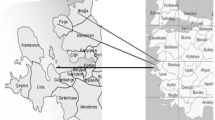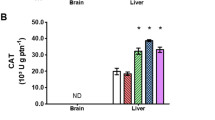Abstract
This study aimed to assess oxidative stress and genotoxicity biomarkers in grey mullet Mugil cephalus from a site receiving discharges from industrial and harbor activities and a reference site in Saronikos Gulf, Greece. Cellular antioxidant defenses, i.e., antioxidant enzyme activities (catalase, selenium [Se]-dependent glutathione peroxidase, glutathione-S-transferase) and oxidative damage, i.e., lipid peroxidation (measured as thiobarbituric acid reactive substances) were used as biomarkers of oxidative stress. The micronucleus test was used for evaluation of chromosome damage, and the frequency of cells with double nuclei was used as an indication of damage to cell divisions. Antioxidant enzyme activities were lower in fish from the polluted site compared with fish from the reference site, suggesting deficiency of the antioxidant system to compensate for oxidative stress. This is further supported by the higher lipid peroxidation levels in fish from the polluted site, which represent oxidative damage. Micronuclei and double-nuclei frequencies were higher in fish from the polluted site compared with fish from the reference site, indicating genotoxic effects. Correlations between biomarkers suggest that observed effects were due to contaminants exhibiting oxidative stress potential that can also induce genotoxicity. Results suggest that the selected biomarkers in M. cephalus are useful for the assessment of pollution impacts in coastal environments influenced by multiple pollution sources.



Similar content being viewed by others
References
Adams SM, Giesy JP, Tremblay LA, Eason CT (2001) The use of biomarkers in ecological risk assessment: recommendations from the Christchurch conference on Biomarkers in Ecotoxicology. Biomarkers 6:1–6
Al-Sabti K, Metcalfe CD (1995) Fish micronuclei for assessing genotoxicity in water. Mutat Res 343:121–135
Amado LL, Robaldo RB, Geracitano L, Monserrat JM, Bianchini A (2006) Biomarkers of exposure and effect in the Brazilian flounder Paralichthys orbignyanus (Teleostei: Paralichthyidae) from the Patos Lagoon estuary (Southern Brazil). Mar Pollut Bull 52:207–213
Arkhipchuk VV, Garanko NN (2005) Using the nucleolar biomarker and the micronucleus test on in vivo fish fin cells. Ecotoxicol Environ Saf 62:42–52
Beliaeff B, Bocquené G (2004) Exploratory data analysis of the Mediterranean component of the BEEP programme. Mar Environ Res 58:239–244
Bolognesi C, Perrone E, Roggieri P, Pampanin DM, Sciutto A (2006) Assessment of micronuclei induction in peripheral erythrocytes of fish exposed to xenobiotics under controlled conditions. Aquat Toxicol 78(Suppl 1):S93–S98
Bradford M (1976) A rapid and sensitive method for the quantitation of microgram quantities of protein utilizing the principle of protein-dye binding. Anal Biochem 772:248–264
Brunetti R, Gabriele M, Valerio P, Fumagalli O (1992) The micronucleus test: temporal pattern of baseline frequency in Mytilus galloprovincialis. Mar Ecol Prog Ser 83:75–78
Cajaraville MP, Bebbiano MJ, Blasco J, Porte C, Sarasquete C, Viarengo A (2000) The use of biomarkers to assess the impact of pollution in coastal environments of the Iberian Peninsula: a practical approach. Sci Total Environ 247:295–311
Çavaş T, Ergene-Gözükara S (2005) Micronucleus test in fish cells: a bioassay for in situ monitoring of genotoxic pollution in the marine environment. Environ Mol Mutagen 46:64–70
Cavas T, Garanko NN, Arkhipchuk VV (2005) Induction of micronuclei and binuclei in blood, gill and liver cells of fishes subchronically exposed to cadmium chloride and copper sulphate. Food Chem Toxicol 43:569–574
Cicchetti R, Argentin G (2003) The role of oxidative stress in the in vitro induction of micronuclei by pesticides in mouse lung fibroblasts. Mutagenesis 18:127–132
Cohen G, Kim M, Ogwu V (1996) A modified catalase assay suitable for a plate reader and for the analysis of brain cell cultures. J Neurosci Methods 67:53–56
Cossu C, Doyotte A, Jacquin MC, Babut M, Exinger A, Vasseur P (1997) Glutathione reductase, selenium-dependent glutathione peroxidase, glutathione levels and lipid peroxidation in freshwater bivalves, Unio tumidus, as biomarkers of aquatic contamination in field studies. Ecotoxicol Environ Saf 38:122–131
De Andrade VM, Da Silva J, Da Silva FR, Heuser VD, Dias JF, Yoneama ML, De Freitas TRO (2004) Fish as bioindicators to assess the effects of pollution in two Southern Brazilian rivers using the comet assay and micronucleus test. Environ Mol Mutagen 44:459–468
De Flora S, Bagnasco M, Zanacchi P (1991) Genotoxic, carcinogenic, and teratogenic hazards in the marine environment, with special reference to the Mediterranean Sea. Mutat Res 258:285–320
Depledge MH, Fossi MC (1994) The role of biomarkers in environmental assessment. 2. Invertebrates. Ecotoxicology 3:161–172
Ergene S, Çavas T, Çelik A, Köleli N, Kaya F, Karahan A (2007) Monitoring of nuclear abnormalities in peripheral erythrocytes of three fish species from the Goksu Delta (Turkey): genotoxic damage in relation to water pollution. Ecotoxicology 16:385–391
Fenech M, Chang WP, Kirsch-Volders M, Holland N, Bonassi S, Zeiger E (2003) HUMN project: detailed description of the scoring criteria for the cytokinesis-block micronucleus assay using isolated human lymphocyte cultures. Mutat Res 534:65–75
Ferreira M, Antunes P, Gil O, Vale C, Reis-Henriques MA (2004) Organochlorine contaminants in flounder (Platichthys flesus) and mullet (Mugil cephalus) from Douro estuary and their use as sentinel species for environmental monitoring. Aquat Toxicol 69:347–357
Ferreira M, Moradas-Ferreira P, Reis-Henriques MA (2005) Oxidative stress biomarkers in two resident species, mullet (Mugil cephalus) and flounder (Platichthys flesus), from a polluted site in River Douro Estuary, Portugal. Aquat Toxicol 7:39–48
Galloway TS, Brown RJ, Browne MA, Dissanayake A, Lowe L, Jones MB, Depledge MH (2004) Ecosystem management bioindicators: the ECOMAN project―a multi-biomarker approach to ecosystem management. Mar Environ Res 58:233–237
Gorbi S, Baldini C, Regoli F (2005) Seasonal variability of metallothioneins, cytochrome P450, bile metabolites and oxyradical metabolism in European eel Anguilla anguilla L. (Anguillidae) and striped mullet Mugil cephalus L. (Mugilidae). Arch Environ Contam Toxicol 49:62–70
Habig WH, Jakoby WB (1981) Assays for the differentiation of glutathione S-transferases. Methods Enzymol 77:398–405
Hatzianestis I, Botsou F (2005). Distribution of organochlorinated compounds in Saronikos Gulf sediments. In: Proceedings of the 9th International Conference on Environmental Science and Technology, Rhodes, Greece, September 1–3, pp B331–336, 2005
Hatzianestis I, Hantzi A, Sklivagou E, Rigas F (2003) Distribution and origin of aliphatic and polycyclic aromatic hydrocarbons in Saronikos Gulf sediments. In: Proceedings of the 8th International Conference on Environmental Science and Technology, Lemnos, Greece, September 8–10, pp 310–317, 2003
Hayes JD, Pulford DJ (1995) The glutathione S-transferase supergene family: regulation of GST and the contribution of the isoenzymes to cancer chemoprotection and drug resistance. Crit Rev Biochem Mol Biol 30:445–600
Heddle JA, Cimino MC, Hayashi M, Romagna F, Shelby MD, Tucker JD, Vanparys Ph, MacGregor JT (1991) Micronuclei as an index of cytogenetic damage: past, present, and future. Environ Mol Mutagen 18:277–291
Hu M-L, Frankel EN, Leibovitz BE, Tappel AL (1989) Effect of dietary lipids and vitamin E in vitro lipid peroxidation in rat liver and kidney homogenates. J Nutr 119(11):1574–1582
Karmakar R, Banik S, Bandyopadhyay S, Chatterjee M (1998) Cadmium-induced alterations of hepatic lipid peroxidation, glutathione S-transferase activity and reduced glutathione level and their possible correlation with chromosomal aberration in mice: a time course study. Mutat Res 397:183–190
Livingstone DR (2001) Contaminant-stimulated reactive oxygen species production and oxidative damage in aquatic organisms. Mar Pollut Bull 42:656–666
Martínez-Álvarez RM, Morales AE, Sanz A (2005) Antioxidant defenses in fish: biotic and abiotic factors. Rev Fish Biol Fish 15:75–88
McFarland VA, Inouye LS, Lutz CH, Jarvis AS, Clarke JU, McCant DD (1999) Biomarkers of oxidative stress and genotoxicity in livers of field-collected brown bullhead, Ameiurus nebulosus. Arch Environ Contam Toxicol 37:236–241
Ochsenkühn-Petropoulou M, Poulea G, Parissakis G (1992) Electrochemical speciation of organotin compounds in water and sediments. Application to seawater after ion-exchange separation. Microchim Acta 109:93–99
Ohe T, Watanabe T, Wakabayashi K (2004) Mutagens in surface waters: a review. Mutat Res 567:109–149
Oliveira M, Ahmad I, Maria VL, Pacheco M, Santos MA (2010) Monitoring pollution of coastal lagoon using Liza aurata kidney oxidative stress and genetic endpoints: an integrated biomarker approach. Ecotoxicology 19:643–653
Orbea A, Ortiz-Zarragoitia M, Solé M, Porte C, Cajaraville MP (2002) Antioxidant enzymes and peroxisome proliferation in relation to contaminant body burdens of PAHs and PCBs in bivalve molluscs, crabs and fish from the Urdaibai and Plentzia estuaries (Bay of Biscay). Aquat Toxicol 58:75–98
Oruç EO, Üner N (2000) Combined effects of 2,4-d and azinphosmethyl on antioxidant enzymes and lipid peroxidation in liver of Oreochromis niloticus. Comp Biochem Physiol C 127:291–296
Padmini E, Usha Rani M (2009) Evaluation of oxidative stress biomarkers in hepatocytes of grey mullet inhabiting natural and polluted estuaries. Sci Total Environ 407:4533–4541
Padmini E, Usha Rani M, Vijaya Geetha B (2009) Studies on antioxidant status in Mugil cephalus in response to heavy metal pollution at Ennore estuary. Environ Monit Assess 155:215–225
Regoli F, Winston GW, Gorbi S, Frenzilli G, Nigro M, Corsi I, Focardi S (2003) Integrating enzymatic responses to organic chemical exposure with total oxyradical absorbing capacity and DNA damage in the European eel Anguilla anguilla. Environ Toxicol Chem 22:56–65
Rodriguez-Ariza A, Peinado J, Pueyo C, Lopez-Barea J (1993) Biochemical indicators of oxidative stress in fish from polluted littoral areas. Can J Fish Aquat Sci 50:2568–2573
Scoullos MJ, Sakellari A, Giannopoulou K, Paraskevopoulou V, Dassenakis M (2007) Dissolved and particulate trace metal levels in the Saronikos Gulf, Greece, in 2004. The impact of the primary wastewater treatment plant of Psittalia. Desalination 210:98–109
Stagg RM (1998) The development of an international programme for monitoring the biological effects of contaminants in the OSPAR convention area. Mar Environ Res 4:307–313
Stephensen E, Svavarsson J, Sturve J, Ericson G, Adolfsson-Erici M, Förlin L (2000) Biochemical indicators of pollution exposure in shorthorn sculpin (Myoxocephalus scorpius) caught in four harbours on the southwest coast of Iceland. Aquat Toxicol 48:431–442
Stephensen E, Sturve J, Förlin L (2002) Effects of redox cycling compounds on glutathione content and activity of glutathione-related enzymes in rainbow trout liver. Comp Biochem Physiol C 133:435–442
Stohs SJ, Bagchi D (1995) Oxidative mechanisms in the toxicity of metal ions. Free Radic Biol Med 18:321–336
Ünyayar S, Çelik A, Çekic FÖ, Gözel A (2006) Cadmium-induced genotoxicity, cytotoxicity and lipid peroxidation in Allium sativum and Vicia faba. Mutagenesis 21:77–81
Van der Oost R, Beyer J, Vermeulen NPE (2003) Fish bioaccumulation and biomarkers in environmental risk assessment: a review. Environ Toxicol Pharmacol 13:57–149
Venkatesha VA, Venkataraman S, Sarsour EH, Kalen AL, Buettner GR, Robertson LW, Lehmler H-J, Goswami PC (2008) Catalase ameliorates polychlorinated biphenyl-induced cytotoxicity in nonmalignant human breast epithelial cells. Free Radic Biol Med 45:1094–1102
Viarengo A, Lowe D, Bolognesi C, Fabbri E, Koehler A (2007) The use of biomarkers in biomonitoring: a 2-tier approach assessing the level of pollutant-induced stress syndrome in sentinel organisms. Comp Biochem Physiol C 146:281–300
Wang TS, Huang H (1994) Active oxygen species are involved in the induction of micronuclei by arsenite in XRS-5 cells. Mutagenesis 9:253–257
Winston GW, Di Giulio RT (1991) Prooxidant and antioxidant mechanisms in aquatic organisms. Aquat Toxicol 19:137–161
Acknowledgments
This research was funded by the General Secretariat for Research and Technology, Ministry of Development, Greece; the Division on Cooperation with International Organizations and Funds, Department of International Scientific and Technical Cooperation, Ministry of Education and Science, Ukraine; and the European Fund of Regional Development in the framework of a Greece-Ukraine Joint S & T project. The contribution of the late Victor V. Archipuk in setting up this research is deeply acknowledged.
Author information
Authors and Affiliations
Corresponding author
Rights and permissions
About this article
Cite this article
Tsangaris, C., Vergolyas, M., Fountoulaki, E. et al. Oxidative Stress and Genotoxicity Biomarker Responses in Grey Mullet (Mugil cephalus) From a Polluted Environment in Saronikos Gulf, Greece. Arch Environ Contam Toxicol 61, 482–490 (2011). https://doi.org/10.1007/s00244-010-9629-8
Received:
Accepted:
Published:
Issue Date:
DOI: https://doi.org/10.1007/s00244-010-9629-8




